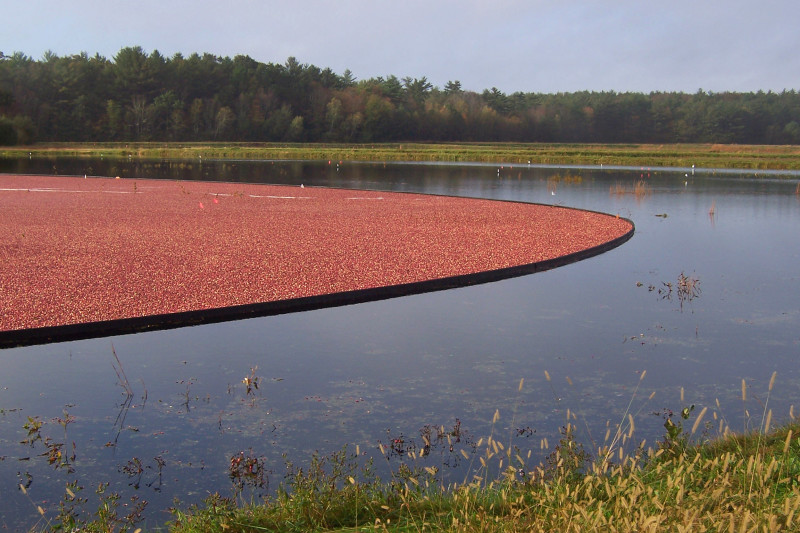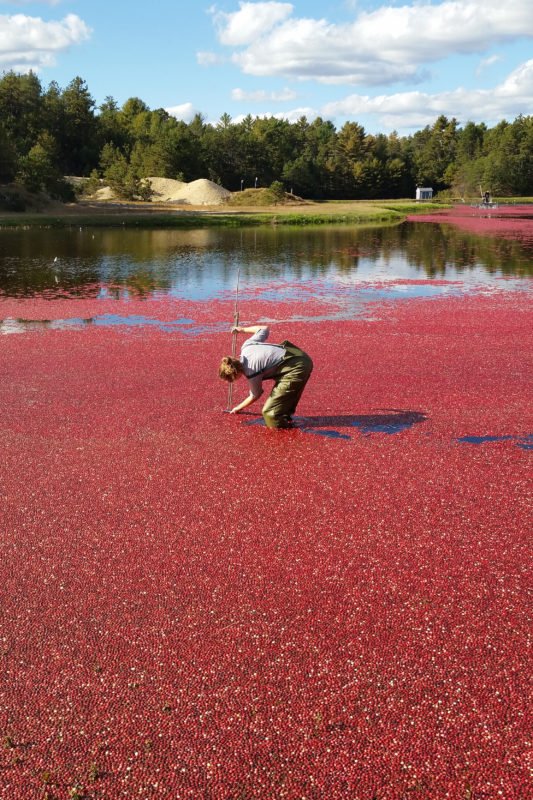New research is unlocking the nitrogen secrets hidden in different types of cranberry bogs
The Buzzards Bay watershed is home to about 8,000 acres of cranberry bogs, which produce nearly 20% of the entire country’s commercial cranberry crop. Cranberry bogs, like all forms of agriculture, contribute nitrogen and phosphorus from fertilizers to wetlands, streams, rivers, and ultimately the Bay – but until recently, there was limited science to show just how much nitrogen pollution cranberry bogs contribute.
In 2016, a study by the Coalition and partners from the UMass Cranberry Station, the Marine Biological Laboratory in Woods Hole, the USDA Agricultural Research Service, and the Woods Hole Research Center found that cranberry bogs differed widely how much nitrogen they discharged, if any. Where bogs sat in the landscape influenced those differences.
To help cranberry growers and decision-makers manage cranberry bogs in a way that benefits the Bay’s health, the Coalition is working together with natural resource scientists and cranberry growers on new research to better understand the role of cranberry agriculture in Bay-wide pollution reductions.
How do cranberry bogs contribute nitrogen pollution to Buzzards Bay?

Fall’s flooded cranberry bogs are scenic — but with all that flood water comes a nutrient called nitrogen, which is the biggest type of pollution fouling Buzzards Bay.
Nutrients – specifically nitrogen – can pollute ponds, streams, rivers, harbors, and larger water bodies like Buzzards Bay when too much gets into the water. Most of the Bay’s nitrogen pollution comes from wastewater, including septic systems and wastewater treatment plants. But there’s another piece of the nitrogen pollution puzzle that’s been harder to pinpoint: cranberry bogs.
Cranberry agriculture is intimately connected to the Bay’s waterways. Growers use nearby ponds and rivers as sources of water to irrigate their crops, protect cranberry plants from frost, and flood the bogs during harvest. When the water is no longer needed, a portion of it gets discharged back downstream. That water carries with it nutrients, like nitrogen and phosphorus, that come in part from fertilizers applied to bogs to help cranberries grow. Additional nutrient losses can happen from beneath the bog, with groundwater exporting nutrients downstream.
Many of the region’s older bogs were built around a river or stream, with water flowing directly through them. Over time, the cranberry industry has worked to retire many of these “flow-through” bogs. The connection of these older-style cranberry bogs to natural waterways make it more difficult to prevent nutrients from reaching downstream waters. Flow-through bogs now only make up about 10-15 percent of all bogs in the watershed.
In total, cranberry bogs have been roughly estimated by the Massachusetts Estuaries Project to account for 30% of the nitrogen pollution to the Weweantic River and 20% to the Wareham River. (The remaining 70-80% is predominantly from wastewater.) These two large Buzzards Bay rivers wind through the towns of Carver, Plymouth, Middleborough, and Wareham, where most of the region’s cranberry agriculture is concentrated.
Murky, nitrogen-polluted water has plagued these rivers for years. Eelgrass beds have died off, leading to less habitat for underwater species, and low oxygen levels don’t allow fish to thrive. In the Wareham River, the Massachusetts Estuaries Project determined that close to 40% of the total nitrogen load to the river needs to be reduced to restore clean water.
What factors influence how much nitrogen comes from cranberry bogs?

Researchers with the UMass Cranberry Station collected water samples from six local cranberry bogs. These samples were then analyzed for nutrients at the Marine Biological Laboratory.
The Coalition and its partners’ previous research quantified how nitrogen flows in and out of cranberry bogs.
“This research was an important step in determining the contribution of cranberry bogs to the overall nitrogen load,” said Coalition Science Director Dr. Rachel Jakuba. “Previous work showed that we needed more detail about when nitrogen was leaking from the bogs, and the factors that influenced how much nitrogen was getting downstream.”
The study took a close look at three bogs in Wareham and Plymouth. Over a two-year period, researchers gathered nearly a thousand water samples to measure nutrients in the water flowing in and out of the bogs. Samples were collected every few days during most of the year, increasing to every few hours when the bogs were flooded. All three bogs received similar fertilizer and flooding management, and their water flows were carefully monitored.
The study produced similar estimates of nutrients coming off the bogs as previous studies – confirming that researchers have a good handle on roughly how much nitrogen is coming from some styles of cranberry bogs. However, there can be significant variation in nutrient runoff from one bog to the next, even with similar fertilizer and water application.
“The differences that we observed between the three bogs make it hard to determine a ‘typical’ nitrogen exchange for all cranberry bogs,” said Dr. Christopher Neill, senior scientist at the Woods Hole Research Center and study lead.
According to the study, the two biggest factors influencing nitrogen discharge off cranberry bogs are time of year and location of the bog in relation to groundwater.
Time of Year

Woods Hole Research Center biogeochemist Lindsay Scott takes water level measurements of a cranberry bog during harvest.
Water samples showed that most nitrogen comes off cranberry bogs during the growing season in a persistent trickle of water, rather than during large floods like at harvest and in winter. This surprised researchers, as many have assumed for years that the release of floodwaters was the source of most nutrient discharge from these bogs.
Although large amounts of water move on and off bogs during floods, this study showed that the majority of water that makes it downstream comes from the smaller trickle flowing out of the bogs during most of the year. Nitrogen travels with this trickle of water into ponds, streams, rivers, and eventually the Bay.
“At one bog, there was very little water in the ditches around the bog during the summer growing season, whereas other bogs had a constant trickle of water from the ditches into adjacent streams,” said Dr. Neill. “The bogs with more of a trickle added more nitrogen to downstream waters.”
Location
The location of the bog is also important because it determines the amount of groundwater that enters the bog. In some cranberry bogs, water applied to the bog soaks through the soil and into the groundwater. Other bogs are located in valleys, where groundwater naturally comes up into the bog.
“Depending on their position in the landscape, some bogs have natural springs of groundwater pushing water into their ditches,” said Dr. Casey Kennedy, a research hydrologist with the USDA. “These bogs are almost always wet, resulting in a slow trickle of water.”
In contrast, Dr. Kennedy explained, other bogs have ditches that dry up in the summertime. “Interestingly, drier soil conditions have been associated with increases in crop production,” she added. “So not only are drier bogs exporting less nitrogen, but they are also producing more cranberries.”
How will this science be used to reduce nitrogen pollution from cranberry bogs?
The Coalition and its partners are now using this science to estimate how much nitrogen is coming from all of the cranberry bogs in watersheds, like those of the Weweantic River and Wareham River. It’s a crucial step for decision makers, who need to develop strategies to manage cranberry bogs to reduce nitrogen pollution and bring these rivers back to health.
With the help of two new grants, researchers will take the detailed information they collected at the three studied bogs and using computer models to simulate how nitrogen pollution could be reduced.
The first grant is a $50,000 award from Woods Hole Sea Grant to the Woods Hole Research Center, which the Coalition is partnering with along with the UMass Cranberry Station and the USDA. Focusing on the Weweantic River watershed, researchers will use the study data as well as new field measurements and mapping to estimate how nitrogen is transported through streams and groundwater to the river.

This new research will help growers and decision-makers manage nitrogen and restore local river health.
“The idea is to identify ways to prioritize problem bogs for decommissioning in a way that will reduce nitrogen inputs to streams that flow to the river,” said Dr. Hilary Sandler, director of the UMass Cranberry Station.
The Coalition is also partnering with the Woods Hole Research Center, the UMass Cranberry Station, the USDA, and the Cape Cod Cranberry Growers Association on a second project, funded with a $47,000 state Water Quality Management Planning Grant to the Southeastern Regional Planning and Economic Development District.
“This study will help communities and farmers understand how much of the nitrogen reduction targets could be met by retiring various cranberry bogs,” said Bill Napolitano, of the Southeastern Regional Planning and Economic Development District.
Focusing on the Wareham River watershed, this project will also incorporate the study data into a computer model, which will examine how different cranberry bog restoration scenarios (along with other nitrogen reduction strategies like expanding sewering and upgrading septic systems) could help decision makers reduce nitrogen loads to the river by 40%.
“Towns have to make decisions on where to invest money to reduce nitrogen pollution,” said Brian Wick, executive director of the Cape Cod Cranberry Growers Association. “This study’s results will help quantify the value of cranberry bogs that are being retired and may be restored to natural wetlands as possible nitrogen reductions.”
Over the coming years, the results of these projects will help inform cleanup plans for the Weweantic River, the Wareham River, and other rivers with large concentrations of cranberry bogs, leading to direct nitrogen reductions to Buzzards Bay.
This project has been financed with federal funds from the U.S. Environmental Protection Agency (EPA) to the Massachusetts Department of Environmental Protection under a s. 604(b) competitive grant. The contents do not necessarily reflect the views and policies of EPA or of MassDEP, nor does the mention of trade names or commercial products constitute endorsement or recommendation for use.